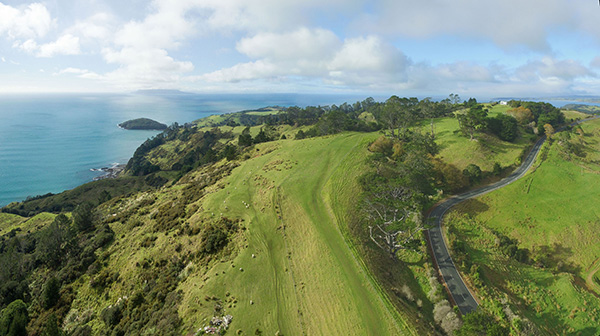Stop road-stopping 1st order of business for new high-level trails trust

Priceless Paper Road: Auckland Transport will be able to do nothing with the few dollars it or the government stands to receive if this paper road was stopped and sold to the adjoining property holder, but as part of the Big Omaha Trail, it is priceless. image Ian Macdonald Big Omaha Trail Trust
The first meeting was two parts fiesta and one part fiasco.
Trails and trails-interested organisations from Pakiri to Pūhoi had gathered to collaborate on creating a rich network of trails, or greenways, to use a term in increasing use in the Auckland region.
The 40-strong gathering began with the sharing of descriptions of the projects of 10 organisations, the most southerly being the Mahurangi Coastal Trail, and the most northerly the Big Omaha Trail, although there was mention of a proposal for a trail even farther north.
The second part of the meeting was billed as an exploration of how the organisations might work together efficiently to progress their common interests. Bizarrely the supposedly independent chairman took it upon himself to jump straight into a hard sell of the proposition that an extant trails trust should, with the addition of a board of representatives of participating organisations, be the high-level entity to act as the sole point of contact with Auckland Council. When asked if the said trust would consider a more inclusive name, the chairman’s response was dismissive, as was, with increasing vehemence, his response to other questions or attempts to explore alternatives. It became increasingly clear that the opportunity for consensus had been squandered and eventually the meeting was allowed to move on to the third and glorious phase—the marking up of maps with trails, actual, proposed and potential.
It is a testament to the passion of the parties involved that the follow-up meeting, 30 days later, proceeded with brisk determination to make up for the earlier false start. And rather than skip directly to discussion of what form of high-level entity might be required to serve the interests of 10 or more organisations, Auckland Council greenways representatives Steve Bramley and Bryce Pomfrett began by very deliberately describing the challenges for their small team in interfacing with myriad trails and trails-interested organisations throughout the region. If northeastern Rodney was taken as a guide, which it probably can’t be, these would number more than 400. Even if the actual number is a fraction of this, it is clear that if communities of interest self-organise to coordinate plans for incrementally building their networks, Auckland Council’s finite greenways resources would go much, much further.
The other critical message that Steve Bramley and Bryce Pomfrett successfully conveyed, is that Auckland Council’s resources will be used to leverage resources from council-controlled organisations, corporations, local boards, national and regional funding agencies and philanthropists, and, thereby, from the communities empowered. In some instances, funding would go directly to a specific trails project, but much would pass through the high-level organisation, a charitable trust, for distribution according to the programme determined by the community.
With the representatives happy to report back to their respective organisations, the meeting nominated four of its number to work on the specifics of the proposed structure and present their recommendations in four weeks. But before closing the meeting, an urgent issue had been added to the agenda:
An eagle-eyed local and supporter of the plans by the Big Omaha Trail Trust for a Pakiri to Big Omaha Valley trail, spotted, on the Pakiri Hill, an Auckland Transport notice advising that an unformed paper road was to be stopped and sold, and amalgamated with the adjoining property. Big Omaha Trail Trust chairman, the retired Anglican bishop, writer, broadcaster and Pakiri resident John Bluck describes the paper road’s importance:
The paper road in question is currently enjoyed as a stunning scenic walk with unparalleled views out across the Hauraki Gulf. It forms a key element in the Big Omaha Trail from Matakana to Pakiri, for both scenic and practical safety reasons as it reduces the need to use the busy Pakiri Road. By using this paper road, we direct walkers from Rodney Road down to a second paper road adjacent to it, and minimise the use of the highway, which has no footpath.
At a time of burgeoning interest in walk and cycle ways across the Rodney district, and in the midst of several separate trail trusts like our own, seeking how to work together and connect the trail network, to sell off this paper road would be short-sighted and a serious setback to the Big Omaha Trail project.
The four-strong steering committee was charged with producing the text of a pro forma objection that the participating organisations, and individuals, might lodge, and the Mahurangi Magazine was volunteered to provide an online pro forma à la those deployed so successfully in support of the Mahurangi Coastal Trail.
